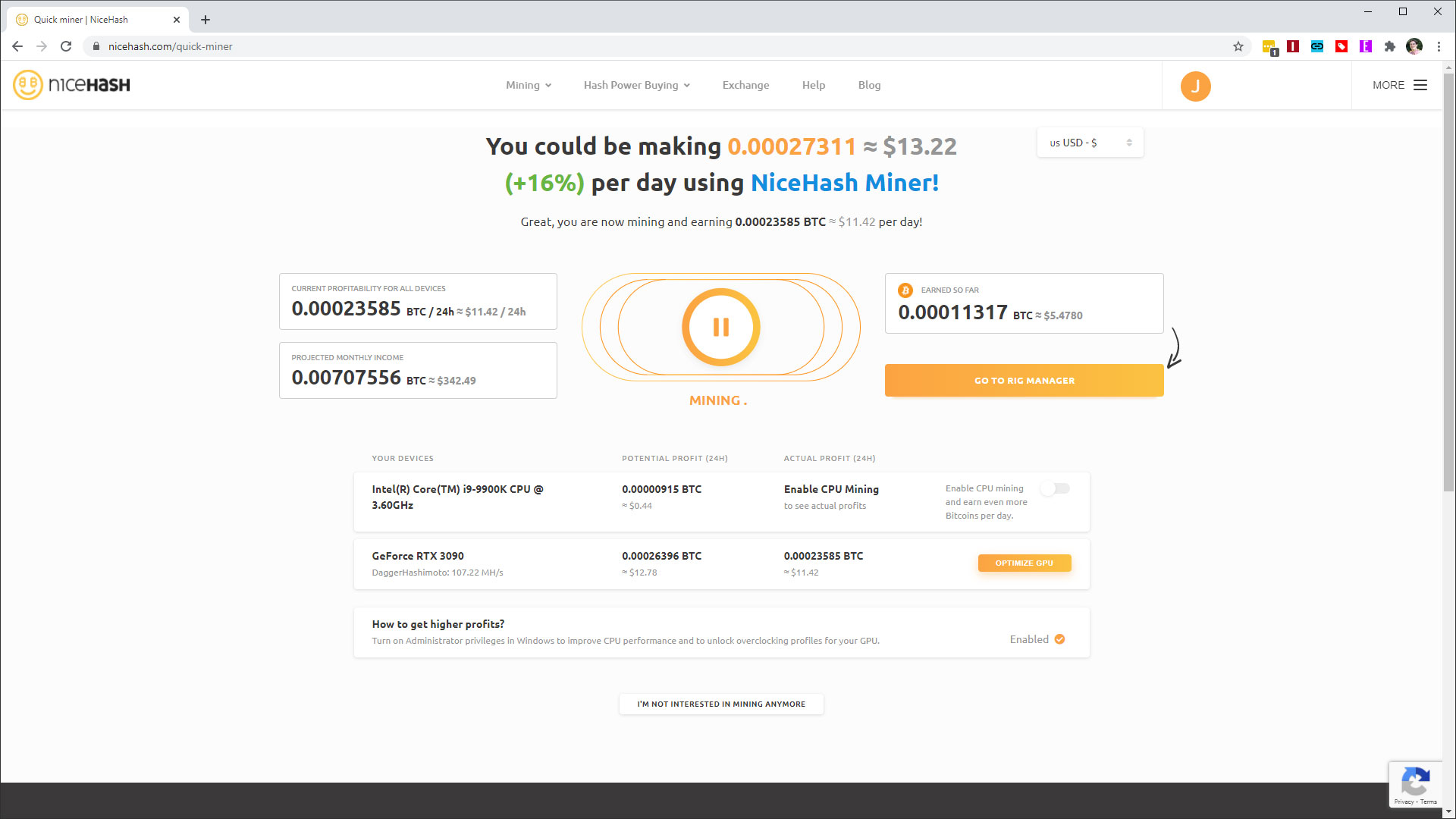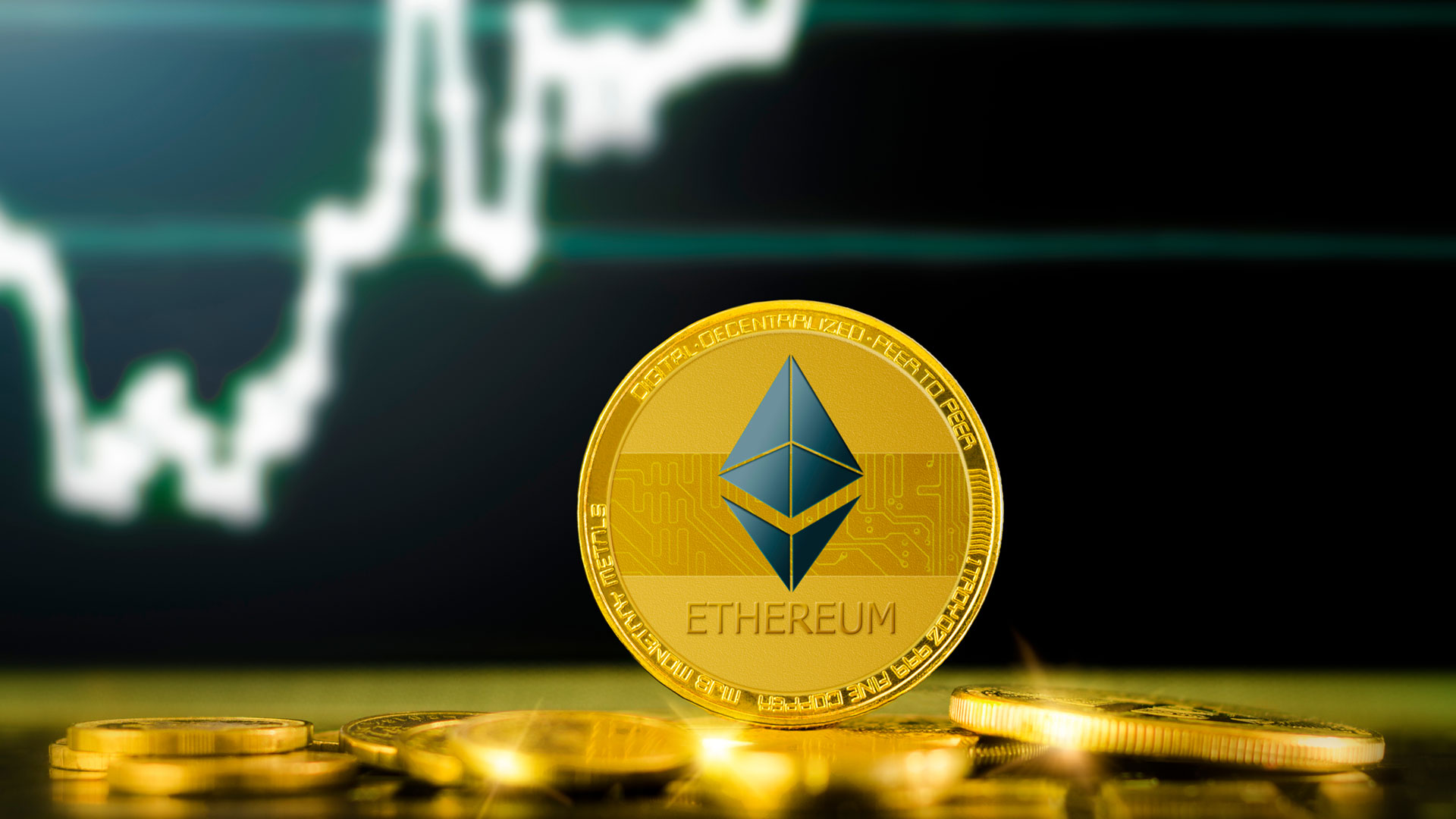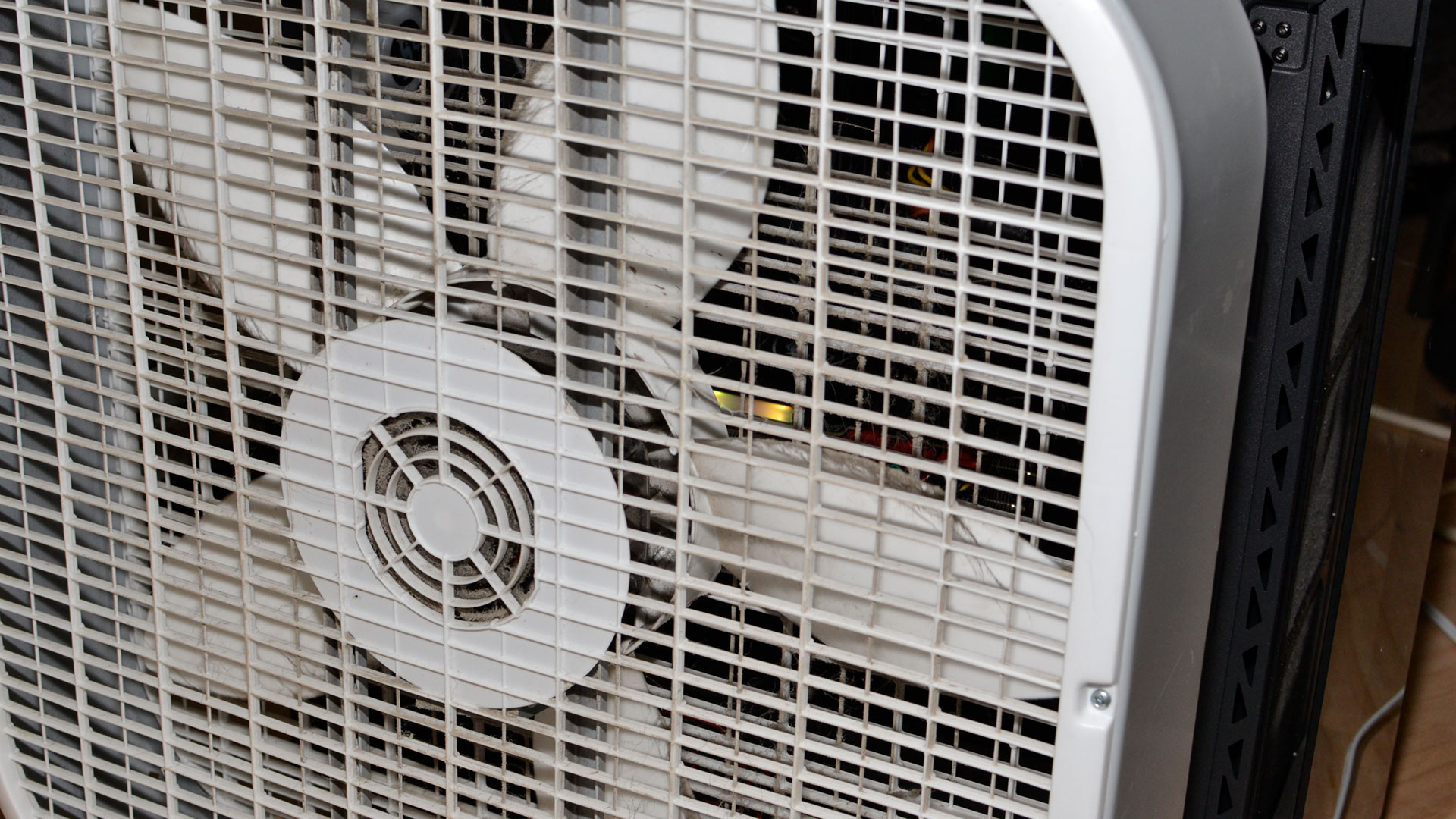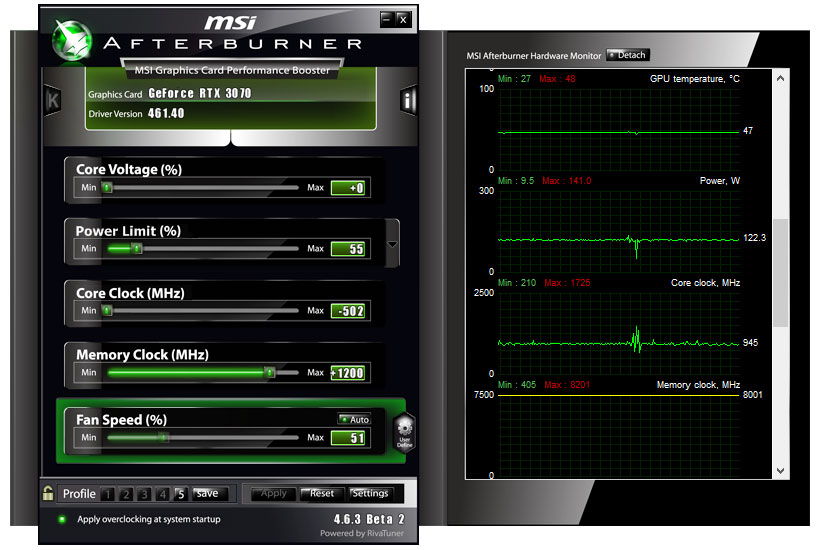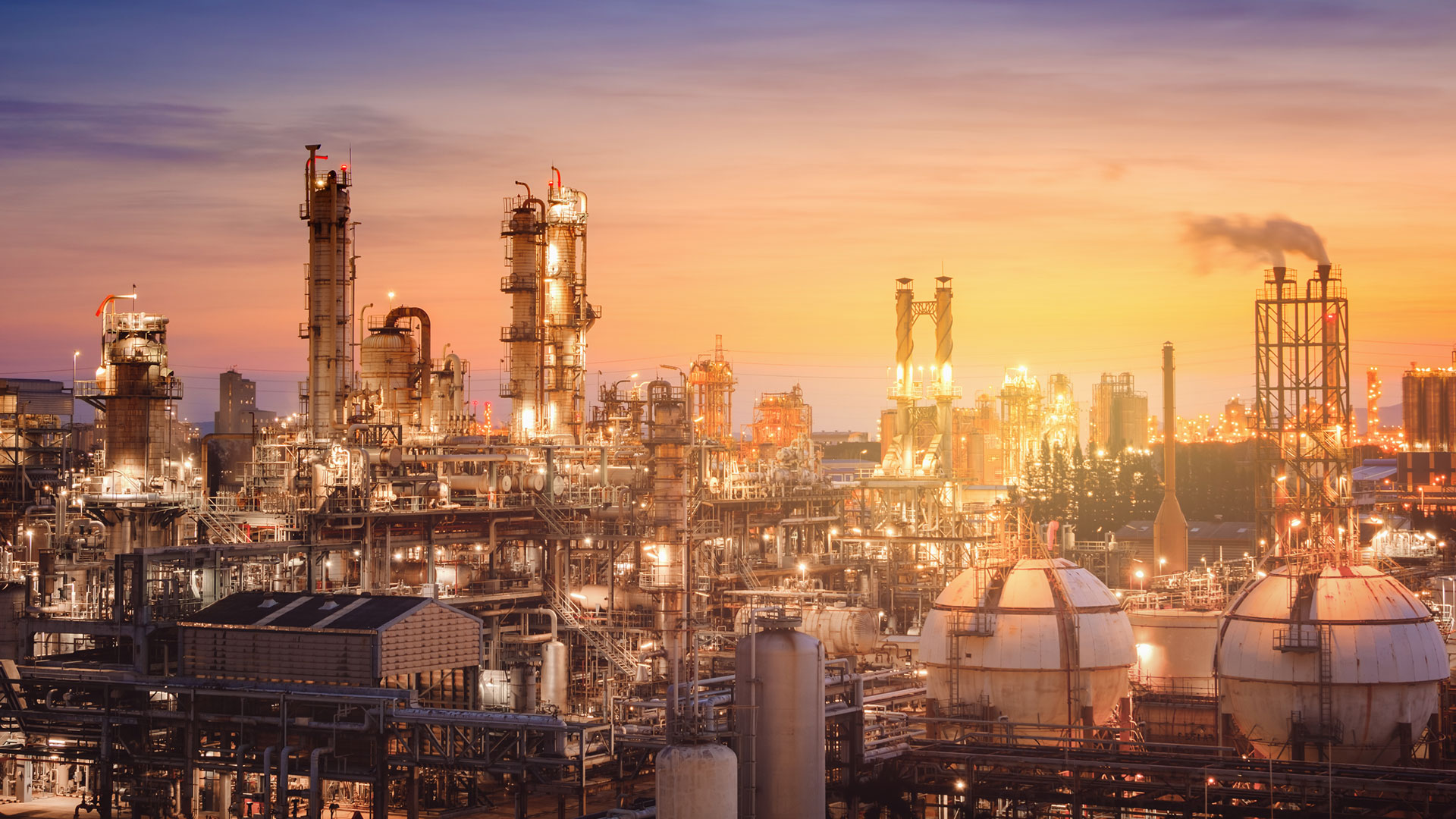How to Mine Ethereum: NiceHash, Mining Pools, Optimal Settings
The pros and cons of cryptocurrency mining (Updated)
The cryptocurrency mining and Ethereum mining boom has mostly tapered off, though even after twelve months, the rollercoaster ride continues. If you've read our best mining GPUs and want to see what all the fuss is about, we've got the details on the most popular ways of mining with your PC. Besides the actual hardware for mining — which basically means having one of the best graphics cards — you'll need to decide on the software you want to run, and how you want to get paid. There are three primary approaches to mining, and we'll cover these in order of ease of getting started.
Before we continue, let's be clear: We're all about providing information, both good and bad. There are GPU shortages, other PC component shortages, GPU prices are in the stratosphere, and clearly there are a bunch of people who think mining is awesome. This has all happened before, and we've seen how it ends — or at least where it goes temporarily. Anyone that had the foresight to put together a big mining farm two or three years ago and then save all the Ethereum and/or Bitcoin it generated (while temporarily eating the costs) looks pretty smart today. At the same time, putting all the money straight into buying cryptocurrencies would have gotten similar results with a lot less hassle.
But what if you're trying to do the same thing right now? It will cost more, profits will be lower (or not even materialize for potentially years, if ever), and there are loads of other concerns that we'll get into.

Case in point: Just look at the past three years. We originally posted this article with data taken from before February 16, 2021. Since that time, we've seen record prices for Bitcoin and Ethereum come and go, multiple times. The difficulty of mining has steadily increased, and potential profits have trended downward over time. Currently, Bitcoin sits at around $38K and Ethereum is at $2,700. That's about a 30–35% drop in value since early December, 2021.
Longer-term stability tends to be at lower profit levels than what we saw in early 2021. Eventually, the difficulty of finding a block increases, or the price drops, either of which will drop the rate of return, and miners stop putting lots of money into scooping up GPUs. Ethereum difficulty initially peaked in May, then declined until late June (no doubt helped by China's crackdown on mining), but has been on a steady upward climb since then and is nearly at 13,000 TH/s. Ethereum also has plans to shift to proof-of-stake (no more mining) in the first half of 2022, however, so GPU miners may soon have to look elsewhere.
That brings us back to the matter at hand. Lots of people still want to know about mining, how it works, and how much they can earn doing it. We'll answer those questions as best we're able, and bring up other concerns and related information that you might not have considered. Hopefully, by the end of it all, you'll be better informed.
How to Mine with NiceHash
The easiest way to get started at mining is with NiceHash. NiceHash launched in 2014, right around the time of the first major spike in cryptocoin mining (second if you want to include Bitcoin's initial "surge" to $32 per BTC in 2011). Prior to NiceHash, getting started with coin mining was more complicated — as we'll detail below. NiceHash has greatly lowered the barrier to entry, and it gets rid of some of the worries about what coin(s) to mine. You effectively lease your PC's hashing power to other users, who get to choose what to mine, and you get paid in Bitcoin. NiceHash takes a small cut of the potential profits, and your PC can be up and mining in minutes.
(Note: There are some alternatives to NiceHash, but generally speaking they function on similar principles. Some just mine the "most profitable" coin at any given time, and you keep those coins (or fractions of a coin). If a coin ends up becoming popular and shoots up in value, you could score big, but it can also go the other way and you end up with a bunch of worthless crypto.
We're not going to walk through every step of the process, as NiceHash already has multiple tutorials. The short summary is that you need to register with the service, and you should have your own Bitcoin wallet somewhere (e.g. at Coinbase or some other service). Then you download the NiceHash mining software, configure it to mine to your BTC address (provided by NiceHash), and you're all set. Your BTC will accumulate on NiceHash, and you can transfer it out whenever you like — which is a good idea since you never know if or when another successful hack might occur.
NiceHash has several options, ranging in degree of complexity. The easiest is to use the new QuickMiner, which is a web interface to a basic mining solution. You download the QuickMiner software, run that, and the webpage allows you to start and stop mining — you don't even need to put in your BTC address. It's dead simple, though the numbers can fluctuate quite a bit. For example, in a brief test QuickMiner suggested we "could be making 16% more" by using NiceHashMiner (which we'll get to next). Except, after letting both versions run for a bit, QuickMiner seemed to stabilize at the same performance level as NiceHashMiner. YMMV.
Next up is NiceHash Miner, which is what most people will want to use. It's more complex in some ways than QuickMiner, but it has more options that can improve overall profitability. By default, it will ask you to log in using your NiceHash account details. Alternatively, you can use the NiceHash app on your phone to scan a QR code, or just input your BTC address manually.
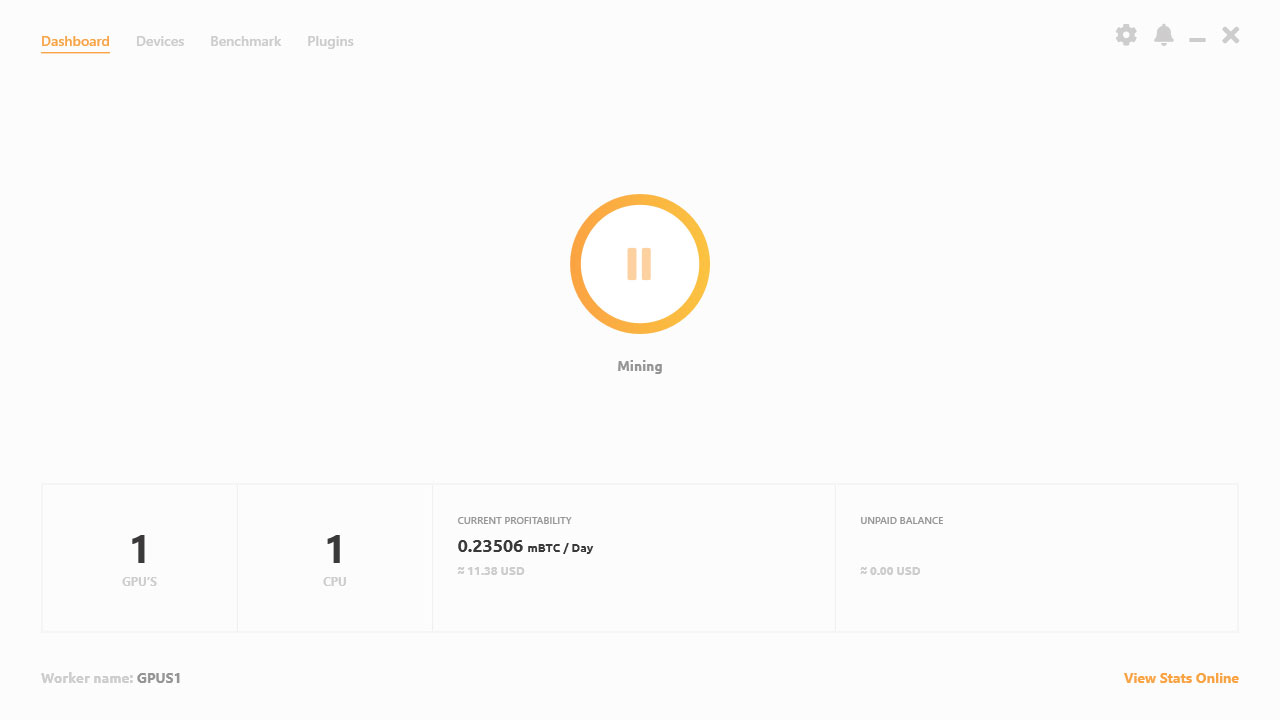
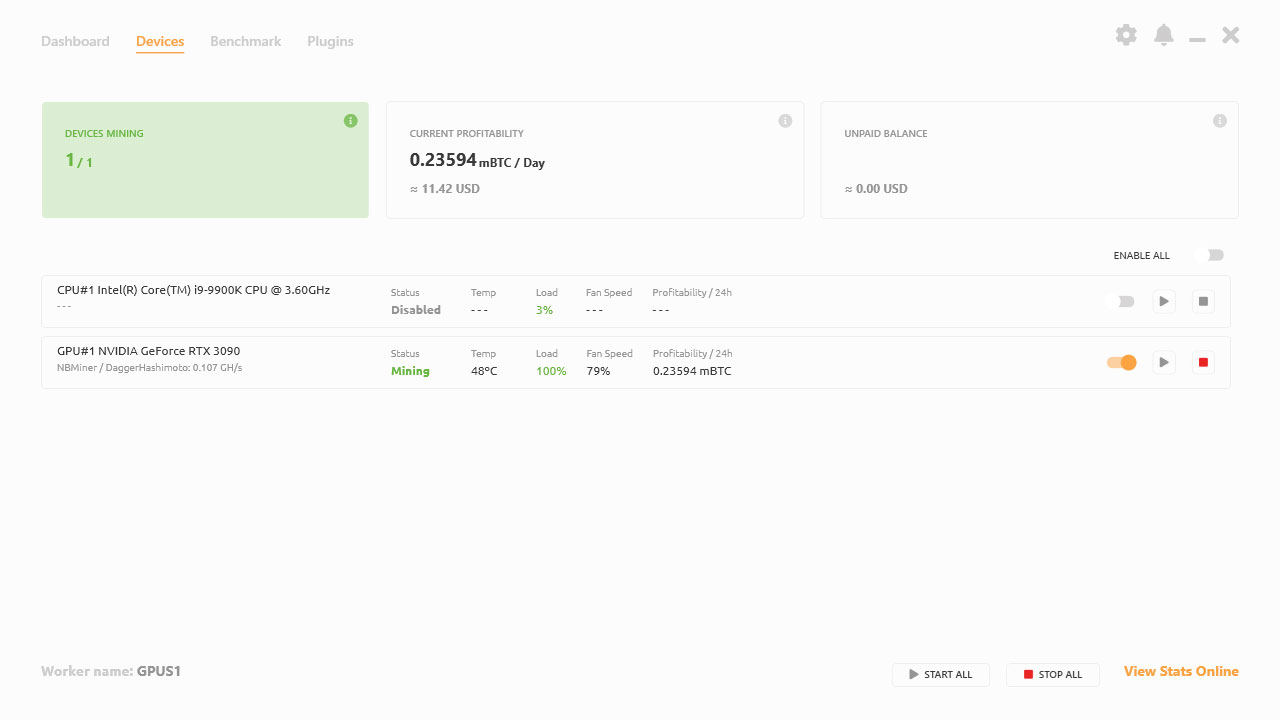

Once launched, the first time it runs, NiceHash Miner will benchmark your hardware using various common mining (hashing) algorithms. Which algorithms and software get tested varies a bit by your GPU, and you can customize things quite a bit. Right now, DaggerHashimoto (aka, Ethash, what Ethereum uses — a modified variant of DaggerHashimoto) tends to be the most profitable, though sometimes Octopus, Kawpow, or some other algorithm might climb to the top.
The idea is that NiceHash Miner will choose whatever is currently the most profitable coin to mine, based on what people are willing to pay to rent your hardware. Sometimes a new coin will launch, or someone will want to dedicate a lot of mining power at a specific coin, and they'll pay more to do so. Instead of mining Ethereum 24/7, you might occasionally run some other algorithm, and it's all managed by the software, which usually (but not always) manages to do a good job.
The initial benchmarks on NiceHash Miner can be a bit prone to error, unfortunately. That's because the tests are only run for a minute each, and as your GPU heats up it may also slow down. That means the first algorithm benchmarked often ends up with an inflated result. You can get a better estimate of performance by using the Precise mode (on the benchmark tab), which takes twice as long to benchmark. You can also manually enter hash rates, so for example if you notice that after 30 minutes or more that NBminer stabilizes at 94MH/s instead of 98MH/s, you can fine tune the mining speed. You can also schedule an algorithm for retesting if you think the result is off, and by default (it can be turned off) NiceHashMiner will periodically download new versions of the miners and automatically retest.
The third and final NiceHash option is to use NiceHash OS. This is a custom Linux installation that would run in place of Windows, and it's recommended for larger scale mining farms that use NiceHash. As with all things Linux, getting it up and running may require a bit more knowledge and patience, but because it's an OS tuned specifically for mining, hash rates can be higher. (We didn't do any of our testing with NiceHash OS, due to time constraints.)
There are two big downsides to mining via NiceHash. One is that you're not actually getting Ethereum — not directly, at least. You'll get paid in Bitcoin, which you can then trade for Ethereum if you want. That's not necessarily a bad thing, considering BTC is the largest of cryptocoins, but if you want ETH you'll need to take some extra steps. The other downside is that NiceHash takes a cut of the amount paid, and the net result is generally lower payouts than mining Ethereum yourself. How big is the difference? Currently, direct Ethereum mining should pay about 7% more than NiceHash. That's a pretty big mining fee, though again the ease of use with NiceHash is hard to overstate.
How to Mine with a Mining Pool
Transitioning over to a mining pool instead of NiceHash opens up more opportunities, to both software and method of payment. Where NiceHash currently only pays out in BTC (again, not necessarily a bad thing), Ethereum mining pools will pay you in ETH. There are still fees to pay — most mining pools take 1–2% of the total income — but that's less than the 7% difference in pay that you might get from NiceHash.
The first choice is what mining pool to use. Generally speaking, you'll get more stable income by going with the largest pool, but there are various reasons for not doing that. Most of those reasons are altruistic, like not wanting any one pool to control too much of the total network hash rate, so our advice is to go with a larger pool. (Google is your friend.) After choosing a pool, you'll need to set up your account, choose which mining software you want to run, and then configure your launch settings. That's simplifying several steps, all of which can vary quite a bit depending on which pool you use.
Pool fees are a critical factor, ranging from 0% to 3% or more. Free pools tend to be less reliable, since it costs money to run the servers and infrastructure for a pool, so it's often better to pay a small fee rather than deal with the potential downtimes. Also pay attention to the payout scheme and payout requirements for the pool. Most pay out your Ethereum daily, provided you've hit minimum quotas, but some of those quotas are pretty high. For example, Ethermine.org has configurable payout limits starting at 0.1 ETH, which would take about a month to reach with a single GPU — a single RTX 3080 will mine about 0.006 ETH per day. It also pays out weekly if you hit at least 0.05 ETH and every 14 days if you've accumulated at least 0.01 ETH. The payout schemes meanwhile are designed to discourage pool hopping (i.e., changing pools if you get a 'hard' work unit or whatever), though we won't get into the intricacies of the various schemes here.
One big difference between NiceHash and your typical mining pool is that you need a separate Ethereum wallet to store your coins — you really don't want to just leave the coins with the pool indefinitely. While it's technically possible to have your coins transferred to somewhere like Coinbase, it's generally best not to have mining pool payouts go directly to a trading platform. We recommend setting up an online wallet, through a service like MyEtherWallet, and use that address for your pool payouts.
PSA: Don't use the same password on any sites related to cryptocurrency mining. Create a unique password on each one (consider using LastPass or a similar product), and if you're planning to hold onto the coins for the long haul, get them into your own wallet.
Once everything is in place, you can finally launch your miner. A lot of the miners have sample configurations for popular pools that you can edit, and the pool itself will have configuration details on how to connect. So as an example, launching T-rex mining with Ethermine looks like this:
t-rex.exe -a ethash -o stratum+tcp://us2.ethermine.org:4444 -u 0x0b8324FcE71D4E6501b5E82aB9466f230A990cB5 -p x -w worker1
That tells the miner what algorithm to use (ethash), the pool server to connect to (Ethermine), the wallet address (put your own address in!), password (none), and worker name. Most modern miners accept a similar syntax, so tweaking the mining command isn't too complicated. Here's the catch: NiceHashMiner has a bunch of extra features to allow remote monitoring, notifications if a miner goes offline, ability to run a script if something appears wrong, etc. Doing all of that with pool mining requires more time and effort, which is why a lot of people are willing to take a bit less in the way of coins.
How to Solo Mine
Don't. No, seriously, it's not worth the hassle and you almost certainly won't actually get any coins — at least not with Ethereum or Bitcoin.
Statistically, your chances of solving a block are equal to your percentage of the total hash rate of the network. With Ethereum, the current network hash rate is now over 1 PH/s, or 1 billion MH/s. Even if you had a farm of 100 RTX 3080 GPUs each doing 95MH/s, that's only 0.0009% of the total. Mathematically, Ethereum averages around 6500 blocks per day, so your odds would be about 6% per day of finding a block, with an 86% chance of hitting a block in about a month. With a single RTX 3080, your odds of hitting a single block in a year are only 20%, and 49% after three years. The proof of stake transition makes any such talk completely irrelevant. In practice, the mining pools have a much higher chance of solving and getting credited with a block.
How much is a single block worth? There's a static block reward of 2 ETH right now, plus transaction fees that currently average around 2 ETH, plus some 'uncle' rewards that are relatively small by comparison. Basically, 3.5 ETH, plus or minus a few percent. At a price of roughly $2,800 per ETH (at the time of writing), that's quite a bit of value, but it only works if you actually solve a block. For all but the most dedicated of mining operations, the steady payouts that come from joining a mining pool are a far safer approach.
But let's say you still want to try solo mining. What do you need to do? First, you have to set up an Ethereum wallet and download the Ethereum blockchain. Even after pruning a bunch of extra data that you don't need, it's still typically around 525GB in size, and downloading can take quite a while. Once your wallet is synced up, you can point your own mining rigs at your local node, which is mostly the same as configuring miners for a mining pool except now you're using your own pool. Congratulations! You're now flying solo.
Even with a lot of high-end GPUs, you likely won't mine any Ethereum before proof of work mining ends. The theoretical benefit to solo mining is that you get the whole block reward plus fees, with no percentage going to the pool. The downside is that without a massive farm, you'll very likely end up getting nothing.
There are however mining pools that operate on a 'solo' mining approach. Basically, the whole pool works together to find a block solution, which means it's more likely to get incorporated as the 'winning' block, but only the participant (mining address) with the highest contributions to date (since the last credited block) gets the reward. This is much easier to use than pure solo mining, but without a decent amount of hashing power it will take quite some time to reach the point where you get the rewards from mining a block. Also, you still end up paying a small pool fee, usually 1%, at which point you should probably just go back to a mining pool with steady payouts.
Get Tom's Hardware's best news and in-depth reviews, straight to your inbox.
Historical Ethereum Pricing, Difficulty, and Profits
That covers how to get started, but we're far from done. With the above information, you can now fire up your PC and begin mining. That's the good news. The bad news is that actual long-term profitability is far less clear cut. The real difficulty is predicting where cryptocurrency will go next. Both Bitcoin and Ethereum are down significantly from their highest ever valuations, but there's still a lot of up and down movement. Maybe it will bounce back, maybe it was a bubble. Who's right? Depending on when you look, you'll find ample data-driven support for just about any opinion.
The most important thing to keep in mind is that cryptocurrencies are volatile. It doesn't matter if you're treating them like a commodity and day trading, or mining, or running a mining pool. Things are in a constant state of flux. Just look at the price of Ethereum since it launched back in 2015. (Note: The following charts were last updated in March, but the patterns outlined here have continued.)
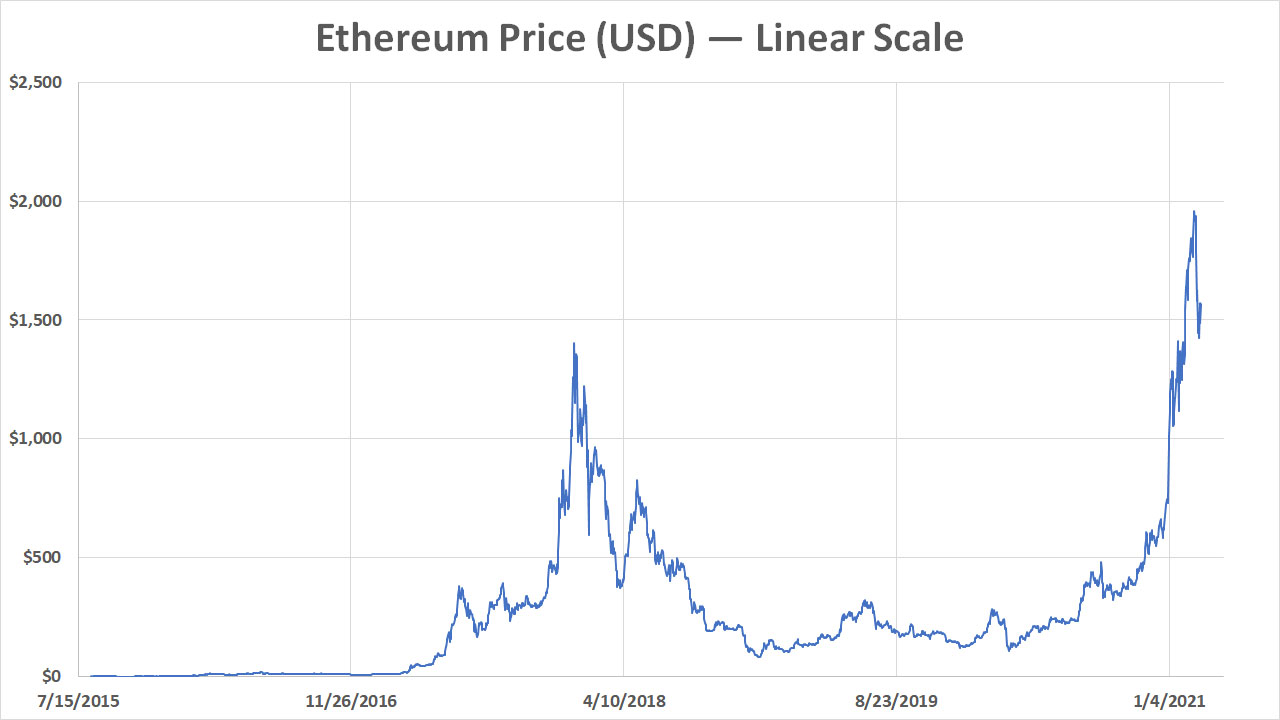
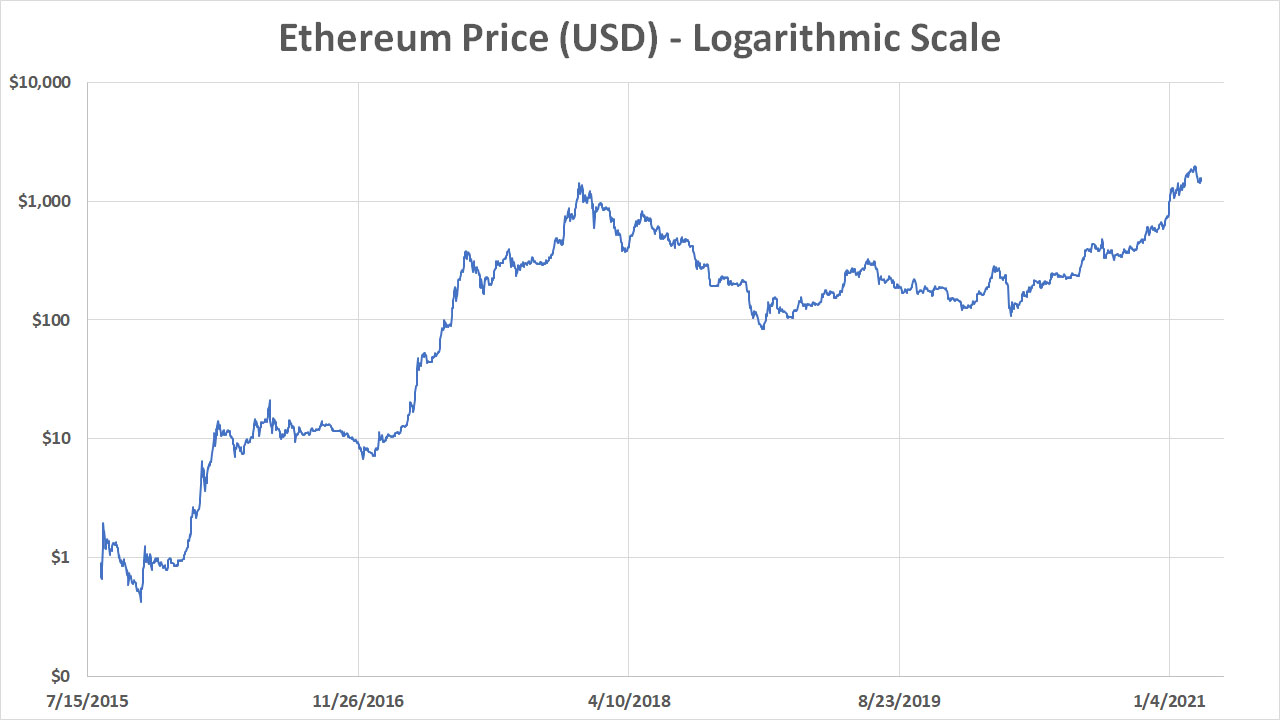
We've got the linear chart, which includes an amazing spike at the right edge (early 2021). That spike looks very similar to the one that occurred in 2017, naturally, and we should maybe just ignore the equally dramatic crash in 2018 — or that's what the optimistic miners seem to think.
The logarithmic chart doesn't look nearly as impressive, and it's clear the real winners with Ethereum are the people who got in back in 2015, or even 2016. Incidentally, about two thirds of all Ethereum was actually part of a 'pre-mine' that went to 'investors' before mining was even possible. Everyone joining the bandwagon now clearly missed the best part of the ride. Alternatively, there's plenty of room left for future growth and spikes, but that's just speculation.
We've passed peak profitability for mining Ethereum, at least for the time being. That's where the HODL (hold) mentality comes into play. Mining for $10–$17 per day on a graphics card that costs $1,000–$1,750 might not seem like a bad idea. Mining at $5 per day is less enticing, and $2 per day or less looks pretty awful. And yet, from August 2018 up until July 2020, Ethereum mining with 100MH/s would have netted less than $2 per day.
There's another way to look at Ethereum mining. If you threw 100MH/s at Ethereum back in 2015, by the end of the year, you'd have around 854 Ether, which was worth about $803 at the time. In 2016, you would have accrued an additional 487 Ether — twice the time mined, a bit more than half the rewards. Of course, the price went up a fair amount in 2016, so your accumulated 1,341 Ether would have been worth over $11,000.
From 2017 up until today, mining has been far less compelling, and it's becoming increasingly so. Over three years of continuous mining at 100MH/s would have only generated 51 Ether. Sure, that's now worth over $100,000, but the early adopters made the big gains. If you got in at the start and mined while holding (and just swallowed the power and equipment costs), your ETH would be worth over $3.75 million.
The point is that you either got in early and made big gains, or you're hoping that things will continue to go up. And if that's your belief, why not just invest in Ethereum directly rather than trying to build a mining farm?
What Settings Are 'Safe' for 24/7 GPU Mining?
Do a quick search for the optimal mining settings on a particular GPU and you're sure to find a bunch of diverging opinions. Some will throw caution to the wind and look to maximize hash rates in pursuit of short-term gains. Let's be clear: These people are very likely to end up with failed hardware. AMD and Nvidia GPUs are tuned somewhat conservatively, with the intent to allow for many hours of gaming, every day, for several years. Push the clocks, fan speeds, and temperatures higher and run them 24/7 in a cryptocoin mining farm and we can guarantee you'll experience component failures at some point. There's a reason Nvidia's CMP cards (Cryptocurrency Mining Processors) target lower hash rates than the consumer Ampere GPUs currently deliver. Striking a balance between raw performance, efficiency, and profits is key.
The difficulty is that what works well on one GPU, and even on one particular card using a specific GPU, may not work everywhere. It's the same old silicon lottery story we see with CPUs, GPUs, and memory. Parts are binned, but some higher quality parts inevitably slip into lower tier products on occasion, and you can almost always get at least 5% more performance (compared to stock) out of any graphics card. 10% might also be possible, but beyond that you're basically redlining your card — meaning, you're pushing well into unsafe territory and your engine might seize up.
We have a whole article about tuning GPUs for optimal Ethereum mining performance, but even that doesn't cover every possibility. Let's discuss things a bit more here, as presumably some of the people reading this are new to mining and GPUs in general and may be led astray by claims made on mining forums. Our advice: Be more cautious and don't chase every last megahash.
First, you need to know what GPU you're using. We use code names a lot, so here's the quick rundown. For Nvidia, Ampere GPUs are found in RTX 30-series cards, Turing GPUs are in RTX 20-series and GTX 16-series cards, and Pascal GPUs are in GTX 10-series GPUs. For AMD, RDNA2 GPUs are used in RX 6000-series, and RDNA1 are used in RX 5000-series (both families are called Navi, but the 5000-series GPUs are Navi 1x and the 6000-series GPUs are Navi 2x); Vega GPUs are in Radeon VII, Vega 64, and Vega 56; and Polaris GPUs are in the RX 500-series and RX 400-series parts. Each family has different features.
Temperatures and Fan Speeds
Temperatures — for all components, not just the GPU core — and fan speeds are a good indicator of what's safe for long-term use, so let's start there. A lot depends on the specific card and fan design, but consumer GPU fans absolutely are not designed to run at 80-100% fan speed and 90-100C temperatures for constant 24/7 use. In fact, on many GPUs the maximum fan speed is normally limited to around 50%. Nvidia's 3090 and 3080 Founders Edition cards won't go above that mark until / unless things go really bad, like super hot GDDR6X temperatures. AMD's Vega cards prefer even lower fan speeds, because no one wants a horribly loud leaf blower while gaming.
With gaming GPUs, the expectation is that cards are only used at most maybe 12 hours per day. So going from 12 hours per day at 40-50% fan speed to 24 hours per day at 80-100% fan speed means the fans will wear out much sooner. A really high-quality fan might last 1-2 years or more; we've had fans in the past burn out in less than six months. Rather than cranking up graphics card fan speeds, an alternate solution is to just get a big and cheap box fan and aim it at your PC. They cost about $20, which is less expensive than replacing fans on your graphics card, but you'll definitely need to dust regularly if you go that route.
If you want a reasonable estimate of where a card should run its fans, turn off the overclock and run a game at 1440p ultra settings and just let it run for 15–20 minutes, and then check temperatures, fan speeds, clocks, etc. Alternatively, use FurMark's 1600x900 stress test, though be warned that sometimes FurMark will heavily throttle the GPU clocks to keep temperatures and fan speeds in check, so sometimes it's actually less demanding than running a game. Either way, the maximum fan speed you see in this scenario is where the manufacturer thinks the card should last 3+ years. Anything above that and you're more likely to have the fans at least fail.
Next, temperatures. Most modern GPUs will have pretty reasonable temperatures on the actual graphics chip, particularly if you follow the advice in our Ethereum optimization guide, but that's not the only critical factor. Memory and VRM (Voltage Regulator Module) temperatures are also factors, but not all GPUs or graphics cards report these items. That makes it a bit trickier to determine what's 'safe' and what might cause premature component failure.
We'll get into the clocks and speeds momentarily, but we think your best long-term bet is to let GPU temperatures hit at most 70C, preferably less. VRM temperatures should be kept to a maximum of 90C (again, preferably less), and we definitely wouldn't run with GDDR6X temperatures of more than 100C and expect a card to remain viable for two years. Maybe that's pessimistic, but we've had graphics cards fail far faster than that in the past, so better safe than sorry is our motto. For GDDR6, aim even lower, like maybe 85C (if your card even reports GDDR6 temps).
If you're using Ampere (RTX 30-series), the 3070 Ti, 3080, 3080 Ti, and 3090 use GDDR6X, and HWiNFO64 can report the memory junction temp. Again, we think if it's above 100C, that's too hot for long-term reliability. It might last a year or more at 106C, or it might last six months — it's tough to say. The RTX 3070/3060 Ti/3060/3050 use standard GDDR6 and the memory temperatures should be quite a bit lower, but we don't know how much lower because these cards don't report GDDR6 temps. AMD's RX 5000/6000 series cards use GDDR6 and report temps via HWiNFO, and could hit 90C at stock, but after tuning for optimal performance they run at around 65–70C in our testing.
Simply put, GPU components (fans, VRMs, memory, capacitors, etc.) can and will wear out. Some of us did a lot of mining back around 2013/2014, and helped other people as well, and we damaged or outright killed quite a few cards by being too aggressive. Some totally failed and some were just very unstable. Nearly all of them had fans go bad, and RMAs were a complete pain. It took 4-6 weeks to get a card back, and some manufacturers even refused warranty service "due to physical damage" or other such claims. The manufacturers are going to see higher RMA rates with another mining boom, and some will use any reason to deny a claim that they can find. #Experience
GPU and Memory Overclocking
Now that we've talked about temperatures and fan speeds, let's talk about overclocking — or even underclocking and undervolting. Memory speed is a key factor in Ethereum mining performance. While tuning memory clocks, you want to pay attention to long-term hash rates. Sometimes, you might bump the memory speed by 5% or more and only see a tiny improvement in hash rate, which means something else (probably GPU clocks or performance) is holding you back. Alternatively, you may find (for example on the Ampere, Turing, and Navi GPU families) that GPU clocks by default run much higher than needed. An RTX 3080 with memory running at 20Gbps and a 1.9GHz core clock will get about 95MH/s while using around 320W of power. Drop the GPU clocks to 1.4GHz and limit the power to 230W and you'll still get about 95MH/s — all of the extra GPU clocks and power are wasted, as the memory speed is the limiting factor.
Beyond pure memory speed, Nvidia's Ampere GPUs have EDR technology on the GDDR6 — that stands for Error Detection and Retry. If the GDDR6 gets an error only 1-2% of the time, it can be detected and the GPU just asks for the data again and usually gets it without an error. This means you can hit higher clocks that aren't unstable, but memory performance actually degrades past a certain point. If you're getting errors caused by memory overclocking on an Ampere GPU, it means you've pushed well beyond the stable limit and we'd back it off at least 10%.
Trying to balance memory clocks against power and temperature is complex, and it's definitely possible to find 'stable' clocks that will end up causing problems down the road. One reasonable approach is to find the maximum stable memory overclock, by bumping the clock speed up in 50–100MHz increments and letting the mining run, until you get errors or a system crash. Once that happens, drop the OC by 10–20% and you should be reasonably safe. So as an example, if you can hit a 1000MHz memory OC, we wouldn't run at more than 900MHz, and 800MHz is probably a better idea for long term use.
Besides overclocking of the memory, you should look into underclocking and undervolting of the GPU, particularly for AMD's previous-generation cards. The Vega and Polaris families are very power hungry at default settings, and it's often possible to drop the voltage by 0.2–0.3V. That's a huge difference, especially since power scales with the square of the voltage. You'll probably need to reduce maximum clocks while reducing the voltage, but the dramatic boost in efficiency makes the effort worthwhile. If you experience crashes or instability, you'll need to tweak the voltages and/or clocks more.
Putting It All Together

Ultimately, the goal of miners is to maximize profits, taking all things into consideration. That means balancing the cost of the hardware, memory speeds, GPU clocks, pool mining fees (or NiceHash fees), power consumption, time required to manage the mining PC(s), the cost to service or replace hardware, and more. Figuring out the optimal balance between all of those factors is complex, and while it might seem tempting to chase after every last bit of hashing performance, that may not be the best long-term solution.
For example, tuning for an extra 5% more hashrate just isn't worth it if it means going from 50% to an 80% fan speed. If you're building a larger mining farm (again, not something we recommend for a variety of reasons), efficiency will be a top priority. The RTX 3090 and RTX 3080 might be the fastest GPUs for mining, but from an efficiency and price perspective, RTX 3060 Ti might be a better choice. Two 3060 Ti cards for example will basically match a single RTX 3090 while using less than half as much power. But let's take things a step further.
A mining farm with a 400 Amp limit (48kW) could run around 150 RTX 3090 GPUs, using six GPUs per PC with just 25 PCs total, and would be capable of around 17.2GH/s. Alternatively, in the same power limit, dropping down to RTX 3080 GPUs would allow for approximately 192 RTX 3080 GPUs spread across 32 PCs, generating around 18GH/s of hashing power (for Ethereum). Finally, using RTX 3060 Ti, it would be possible to install about 60 PCs with six GPUs each, with an output of about 21.6GH/s. (That's only a rough estimate and does not include AC or other items that potentially need power.)
But what would those mining farms cost? We've put together a rough estimate of hardware costs per PC. That includes an 80 Plus Platinum PSU (two for the 3080/3090 builds), PCIe riser adapters, fans, a basic CPU, a motherboard with at least six PCIe slots, 16GB memory, and SSD storage. Plus all the GPUs, naturally, at current eBay prices. Without the GPUs, the price per PC is around $760 for the RTX 3060 Ti builds (one PSU) and $1,015 per PC for the 3080/3090 builds (two PSUs). Median prices at eBay on the 3060 Ti are currently $925, $1,600 for the 3080, and $2,600 for the 3090.
That gives a total cost of $6,310 for each mining PC using RTX 3060 Ti cards (assuming you can even acquire enough of them), $10,615 for the 3080 PC, and $16,615 for the 3090 build. Yeah, that's a ton of money. You can get about 360MH/s from the 3060 Ti PC, 570MH/s from the 3080 build, and 690MH/s from the 3090 PC. Power estimates based on our testing indicate the 3060 Ti PC would use about 800W, including PSU inefficiency and the rest of the PC, while the 3080 would need around 1500W and the 3090 would consume 1900W.
Based on those prices, power use, and hash rates, we can determine approximate break-even time (not including rental space or AC). The 3090 PCs would currently net about $22.20 per day, so it would take ~748 days to break even — assuming nothing changes with Ethereum prices or difficulty, which is obviously not going to be correct. The RTX 3080 PC would net around $18.50 per day, requiring ~574 days to break even. Finally, the RTX 3060 Ti build would net approximately $12 per day and require ~526 days to break even.
Hopefully, that explains how far things have fallen. Factor in the warehouse space to accommodate all those PCs, power distribution, and paying someone (even yourself) to build and maintain all the mining PCs would also be necessary. If you're doing a bunch of mining rigs, you'd be using a lot of electricity, and power use would probably be 50% higher than the pure PC power use once you factor in IT infrastructure and cooling. Those would add to the cost, pushing back the break even point, and if things take a change for the worse (as they did in 2014 and 2018), the whole operation comes crashing down.
Don't Forget Nvidia's LHR Limiter
If all of that weren't already bad enough (for miners), Nvidia also updated all of its Ampere GPUs with LHR limiters — Lite Hash Rate. Basically, LHR models are the main type of RTX 30-series cards you'll now find, and hash rates can be cut by 50% relative to the original models. Non-LHR cards cost more, but would probably be worth the premium if you're serious about mining. Note that the RTX 3090 does not have an LHR variant, but of course the cost of those cards is already prohibitively high and other models are a better choice.
AMD for its part has done nothing to directly curb mining performance or profitability. The RDNA2 architecture relies on a large Infinity Cache to boost gaming performance, and that doesn't really help much with mining performance, so even the RX 6900 XT as an example only gets about the same mining performance as a (non-LHR) RTX 3070/3060 Ti.
Also, note that the LHR limiter only affects Ethereum mining. That's going to end in the coming months regardless, and it's possible some other coin (more likely coins) will take Ethereum's place as the best option for GPU mining. Note that right now, however, the best non-ETH coins tend to generate about half as much value per day.
The Power of Mining
Bottom line: We're not big fans of large cryptocoin mining farms. There are arguably worse ways to use power and money, but there are also a lot of better ways — ways that don't carry nearly the volatility and risk of coin mining. Never mind the fact that procuring all of the necessary equipment takes time and a lot of money, or that it makes it difficult for PC enthusiasts to upgrade their PCs. The bigger issue, by far, is that it's putting a ton of computing power to the task of merely securing the blockchain.
Best-case, using the most efficient hardware, the Ethereum network would currently use over a billion watts of power, and Bitcoin would use over 5.5 billion watts — but it's actually a lot more in both cases, as a large chunk of the hashing isn't done by the absolute most efficient hardware. Digiconomist pegs the current power use of the Ethereum network at around 110 TWh per year, and 260 kWh per transaction. Basically, Ethereum hashing uses 300 GWh every day, which would cost around $30 million. There's $26 in power costs (using $0.10 per kWh) just to send Ethereum from one wallet to another. It offsets those costs by minting (creating) about $35 million in new Ethereum coins per day (at current rates).
Ethereum aims to 'solve' all of these issues by switching from proof of work to proof of stake in the coming months. That's great for power consumption, but it remains to be seen whether Ethereum will continue to be popular once mining stops, and there will still be plenty of other alternative coins that still use proof of work.
Looking at all the costs and power going into these networks, it's difficult to remain optimistic about their long-term potential. We're strip-mining digital coins, basically, and that's unsustainable. At some point, this all hits a plateau, and short of zero point energy or some future technology that allows for clean power far beyond what we currently use, there's a very good chance the viability of mining eventually stops. Maybe that's not this year or next year, but the growth in hash rates, power use, and prices obviously can't go up indefinitely, and it won't. Cryptocurrency networks are designed to find a 'stable' equilibrium, which effectively means getting enough people to believe in and use the coin to make it viable. Equilibrium almost certainly isn't going to be highly profitable.
Do you still want to mine? That's your choice. We've provided the information here that allows you to get started. We've also provided a realistic view of what to expect, so hopefully you fully understand the risks. TL;DR: Don't bet the farm or your retirement on PC hardware and upgrades solely used in pursuit of mining. We also recommend mining at conservative settings until you've at least paid for the hardware you bought, which could take over two years. We'll see how long this crazy cryptocurrency ride remains viable, but don't be surprised if that's not nearly as long as you'd need to turn a healthy profit, as that ship likely already sailed.

Jarred Walton is a senior editor at Tom's Hardware focusing on everything GPU. He has been working as a tech journalist since 2004, writing for AnandTech, Maximum PC, and PC Gamer. From the first S3 Virge '3D decelerators' to today's GPUs, Jarred keeps up with all the latest graphics trends and is the one to ask about game performance.
-
octavecode The mining madness needs to end soon...Reply
Power outages all over the world cause of some idiots trying to get easy money, probably never had a real job in their life, wasting energy while warming the planet.
This has to stop. -
VforV Reply
I want it to stop too, but that doesn't mean it will happen soon... It could crash tomorrow theoretically, but looking at the way things are now I'm more pessimistic and I think it can easily take 1 year before the craze ends... 😕octavecode said:The mining madness needs to end soon...Power outages all over the world cause of some idiots trying to get easy money, probably never had a real job in their life, wasting energy while warming the planet.
This has to stop. -
gg83 Thank you so much for this article! its really informative and exactly what I wanted to know about mining. I knew it was ridiculous but I didn't know it was that bad. think of all the clean water you could make with that much power! You could pull a ton of people out of poverty permanently with the money spent on mining! Making small loans to entrepreneurs would generate more profits I'm sure. Think of all the "startups" that could sell out and make a huge profit.Reply -
mrv_co I wonder how many people have a mining PC sitting under their desk at work connected to guest WiFi w/ their employer unknowingly paying the electric bill.Reply -
Findecanor Many economists have likened the major "mined" cryptocurrencies to pyramid schemes. You make the most money based on people who enter after you.Reply
Therefore, whenever you see someone post information on how to get into cryptocurrency, be wary that they may not have your best interest at heart.
Etherium is in a transition from "proof-of-work" (i.e. mining) to "proof-of-stake" (who owns most) for validating transactions. This will make it even less profitable to mine it (and maybe mining will stop completely) but will still benefit those who are already higher up in the pyramid. -
Richmond2000 nice overview articleReply
one point not brought up is that the wattage consumed is turned into HEAT and at the numbers talked about for the FARMS that is a LOT OF HEAT to deal with
an employer I used to work at has a 15000 square foot workshop and running ASIC miners in ONE corner HEATED the shop to over 30C in a Canadian WINTER / the doors were left partly open to control the heat
I will say mining on "home sized" rigs during the HEATING season should be LOW COST as far as energy is concerned as the POWER being turned into HEAT is heating domestic space and displacing other heating sources -
Kosm0 HiReply
Why is it better to pay out to a wallet than to pay out to an exchange wallet? It is mentioned in this article but it isn't explained

